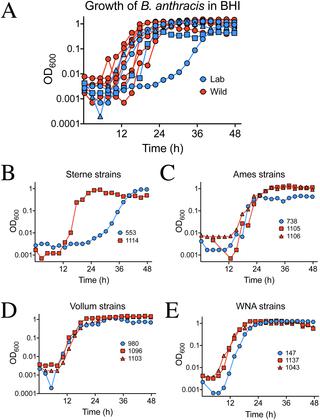Our official English website, www.x-mol.net, welcomes your
feedback! (Note: you will need to create a separate account there.)
Laboratory strains of Bacillus anthracis lose their ability to rapidly grow and sporulate compared to wildlife outbreak strains.
PLOS ONE ( IF 2.9 ) Pub Date : 2020-01-24 , DOI: 10.1371/journal.pone.0228270 Michael H Norris 1, 2 , Diansy Zincke 1, 2 , Owen P Leiser 3 , Helen Kreuzer 3 , Ted L Hadfied 1, 2 , Jason K Blackburn 1, 2
PLOS ONE ( IF 2.9 ) Pub Date : 2020-01-24 , DOI: 10.1371/journal.pone.0228270 Michael H Norris 1, 2 , Diansy Zincke 1, 2 , Owen P Leiser 3 , Helen Kreuzer 3 , Ted L Hadfied 1, 2 , Jason K Blackburn 1, 2
Affiliation

|
Bacillus anthracis is the causative agent of anthrax in animals and humans. The organism lies in a dormant state in the soil until introduced into an animal via, ingestion, cutaneous inoculation or inhalation. Once in the host, spores germinate into rapidly growing vegetative cells elaborating toxins. When animals die of anthrax, vegetative bacteria sporulate upon nutrient limitation in the carcass or soil while in the presence of air. After release into the soil environment, spores form a localized infectious zone (LIZ) at and around the carcass. Laboratory strains of B. anthracis produce fewer proteins associated with growth and sporulation compared to wild strains isolated from recent zoonotic disease events. We verified wild strains grow more rapidly than lab strains demonstrating a greater responsiveness to nutrient availability. Sporulation was significantly more rapid in these wild strains compared to lab strains, indicating wild strains are able to sporulate faster due to nutrient limitation while laboratory strains have a decrease in the speed at which they utilize nutrients and an increase in time to sporulation. These findings have implications for disease control at the LIZ as well as on the infectious cycle of this dangerous zoonotic pathogen.
中文翻译:

与野生动植物爆发菌株相比,炭疽芽孢杆菌的实验室菌株失去了快速生长和发芽的能力。
炭疽杆菌是动物和人类中炭疽的病原。生物体在土壤中处于休眠状态,直到通过食入,皮肤接种或吸入引入动物。一旦进入宿主,孢子就会萌发成迅速生长的营养细胞,并产生毒素。当动物死于炭疽病时,在空气中存在时,由于bacteria体或土壤中养分的限制,营养细菌会发芽。释放到土壤环境后,孢子在car体及其周围形成局部感染区(LIZ)。与从最近的人畜共患病事件中分离出来的野生菌株相比,炭疽芽孢杆菌的实验室菌株产生的与生长和孢子形成有关的蛋白质更少。我们证实,野生菌株比实验室菌株生长更快,表明对营养物质的利用率更高。与实验室菌株相比,这些野生菌株的孢子形成明显更快,这表明野生菌株由于养分限制而能够更快地形成孢子,而实验室菌株利用养分的速度降低并且孢子形成时间增加。这些发现对LIZ的疾病控制以及这种危险的人畜共患病原体的传染周期都有影响。
更新日期:2020-01-26
中文翻译:

与野生动植物爆发菌株相比,炭疽芽孢杆菌的实验室菌株失去了快速生长和发芽的能力。
炭疽杆菌是动物和人类中炭疽的病原。生物体在土壤中处于休眠状态,直到通过食入,皮肤接种或吸入引入动物。一旦进入宿主,孢子就会萌发成迅速生长的营养细胞,并产生毒素。当动物死于炭疽病时,在空气中存在时,由于bacteria体或土壤中养分的限制,营养细菌会发芽。释放到土壤环境后,孢子在car体及其周围形成局部感染区(LIZ)。与从最近的人畜共患病事件中分离出来的野生菌株相比,炭疽芽孢杆菌的实验室菌株产生的与生长和孢子形成有关的蛋白质更少。我们证实,野生菌株比实验室菌株生长更快,表明对营养物质的利用率更高。与实验室菌株相比,这些野生菌株的孢子形成明显更快,这表明野生菌株由于养分限制而能够更快地形成孢子,而实验室菌株利用养分的速度降低并且孢子形成时间增加。这些发现对LIZ的疾病控制以及这种危险的人畜共患病原体的传染周期都有影响。











































 京公网安备 11010802027423号
京公网安备 11010802027423号